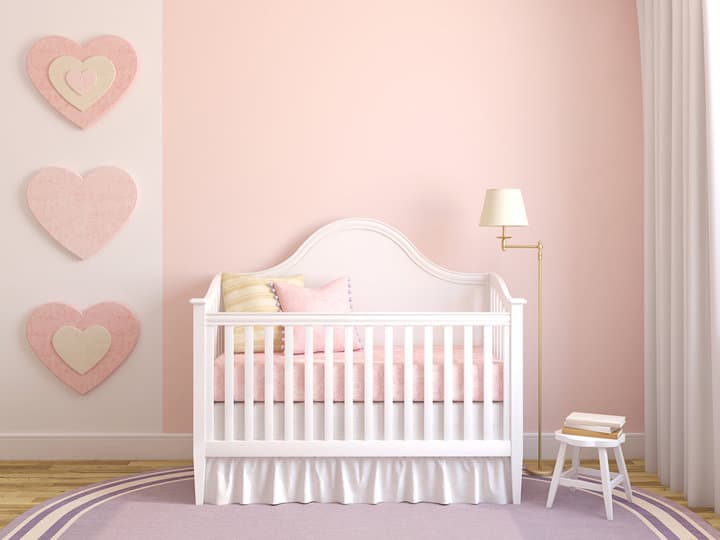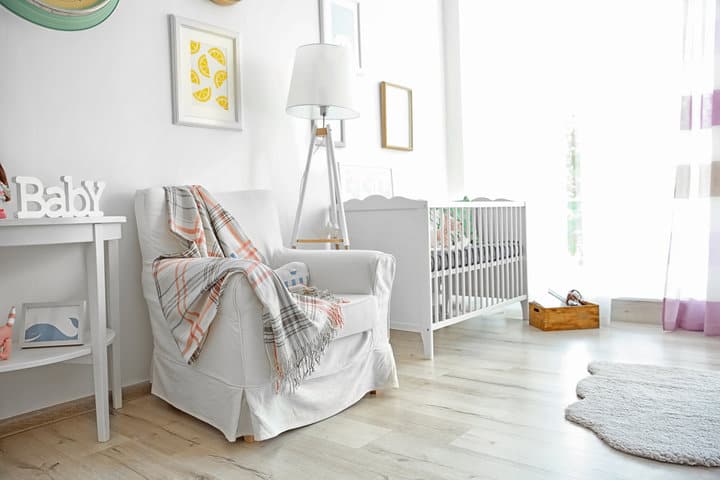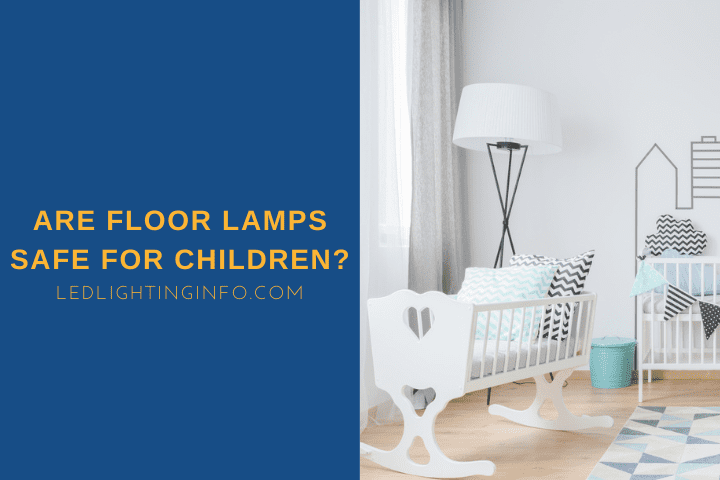Whether you’re currently expecting your first child and planning your first nursery, or your child has asked for a themed bedroom makeover, one of the things you’ll want to consider is lighting.
Lighting choices are just as important in a child’s room as anywhere else.
Perhaps even more so, as you ensure the room is safely lit without harm to their developing vision.
One option you may consider is a floor lamp (or two), but are they safe for children?
Floor lamps can be safely used in a child’s room with the proper precautions. Lamps should either be placed out of reach, behind other furniture or anchored to a wall hook. Certain lamps with wide, heavy bases may be OK without these measures, but cords should always be hidden.
In this article, I’ll explain:
- Whether it is safe to use a floor lamp in a nursery
- The best brightness for children’s bedrooms
- Childproofing an existing floor lamp
- Anti-tip lamps, and where to buy them
Is It Safe To Put A Floor Lamp In A Nursery?

When setting up a nursery for a newborn baby, you need to strike a balance between the needs of the child and that of the parents.
While it is the baby’s room, the parents will no doubt be spending a lot of time there helping soothe the child to sleep, feed them, or spend some time with them!
So you’ll want to get the right lighting for everyone.
Table lamps are generally less safe since they’re more prone to being knocked over, so how about floor lamps?
Floor lamps are generally safe to use in a nursery when the baby is in their formative few months and isn’t very mobile.
As soon as the baby becomes mobile, floor lamps become a hazard unless you’ve appropriately child-proofed them.
Especially with the inquisitive nature of younger toddlers who love to pull, bite, chew, and grab onto anything and everything.
After all, anything upright could potentially be knocked over, which could lead to injury from the lamp striking the child or from the lamp or bulb breaking, and potentially there could be a risk of electrocution.
Provided you take the proper precautions to keep the lamp safe – and I’ll take you through those below- they can be used in a nursery.
What Brightness Is Best For A Child’s Room?
Floor lamps are a good idea for a child’s bedroom because they are less harsh than a pendant light in the center.
After all, a pendant light will always be above the baby when lying on their back, even if the cot is on the other side of the room.
A floor lamp is lower and so will still illuminate the room, but when placed away from the cot, it won’t be as harsh.
Still, you need to choose the right kind of bulb and the right type of floor lamp. Ideally, you’ll want one shaded or diffused rather than an exposed bulb.
A shade will also provide a small amount of protection if the lamp were to be knocked over.
In terms of bulb brightness, the lumens you need will depend on the size of your room, but as a guide, bedrooms should be around 100 lux on average.
Multiply the length and width of the nursery in meters to get the area, and then multiply that by 100 to get the total maximum lumens needed for all lights in the room.
Finally, light color matters too. You should avoid any bright white bulbs that are 5000K or higher.
Aim for a soft white or daylight bulb, as these should be more gentle on your baby’s eyes.
How To Child Proof An Existing Floor Lamp?

There are many different ways that you can child-proof your floor lamp.
These will help secure the lamp and prevent problems with the cord or the plug.
You need to make sure that:
- The lamp can’t be knocked over easily
- The cord can’t be damaged
- The plug is safe
In terms of preventing the lamp from being knocked over, you have several options.
Ideally, you want one with a wide, solid base.
The wider the base, the less likely the lamp can be to topple, especially if it is too heavy to be lifted by a child.
But this is a delicate balance because if it is heavy, yet not so heavy that it can’t be toppled, that makes it more dangerous since it’s a heavier weight that could strike your child.
If you can position the lamp behind other furniture so it can’t be reached, that’s ideal.
Otherwise, you’ll want to anchor the light to the wall or another sturdy piece of furniture.
You’ll have to do this with a cable tie or a cord tied to a wall hook or other anchor point.
It can still be discreet, primarily if you use clear nylon thread that is barely visible.
Next up is solving the cord problem.
If the floor lamp has a cord hanging loose from the bulb, you’ll want to ensure it is tied closely to the lamp’s central pole via cable ties.
Many floor lamps run the cable through the fixture already, with the cord running loose from the base.
Make sure the cord is somewhere other than where it can be pulled.
You could cover it with a rug if it needs to run a significant length to the wall, or ideally, just run it along the wall – direct the cable to the nearest point of the wall and use cable clips to then keep it tight to the wall until you reach the plug.
Alternatively, look for a cordless floor lamp that relies on battery power.
Once you reach the plug, you still want to keep the cord tight to the wall, so look for a self-adhesive cord channel so that you can safely run it up to the plug.
Finally, you want to make sure the plug itself is safe.
You don’t want little fingers to be able to pull the plug out from the wall and potentially touch any connectors.
Plug covers make this easy. These simple clips cover up a plug completely and can be installed in seconds.
You must unscrew the middle screw on the existing outlet cover, put the new cover base, and then re-insert the screw to hold it in place.
Then plug in the lamp and clip the cover over the top using the cover base.
If you follow all of these steps, you can ensure the lamp can’t be tipped over and that the plug and cord are safe.
How To Select An Anti-Tip Floor Lamp?

Floor lamps have a vast range of designs; some are more prone to being tipped over than others.
So when choosing a floor lamp for a child’s room, or a space where children will spend a lot of time (because they aren’t confined to their own bedrooms!), you should choose one that is designed to be harder to tip over.
Bad lamps to choose from are any that are square or tripod lamps.
While these are sturdy if you grab them from a corner, if you grab them and pull them towards a flat side of the base, they are a lot easier to topple.
The best lamps are those with a large flat base and a slim pole, ideally central.
Something like this brushed nickel lamp or this wooden arc lamp would be a good choice.
That’s because when you pull on the central pole from a lower height (the typical height a crawling baby or standing toddler might be), the pressure pushes the flat base into the floor, so it won’t just fall over.
Pull on it from a higher height, and you’ll have the leverage to tip it, but by the time your child is old enough to do that, they should know better!
Some lamps have the pole situated to the edge of a flat base, such as this overhanging floor lamp.
These are easier to pull over if you are on the side of the lamp where the pole is but even harder to topple from the far side.
So if you’re placing a lamp in the corner of the room, you can use a lamp like this with the pole tucked into the corner, and it should be very, very difficult for your child to pull to the ground.
Final Words
If you’re worried about putting a floor lamp in a nursery, that’s a good sign that you’re aware of the potential dangers these types of furnishings could cause.
You don’t need to completely avoid them, though; they can be a good choice for lighting up the room if you properly child-proof them, including the cord and plug.
Have you ever used floor lamps in a child’s room or decided on something else?
Looking for an LED bulb but not sure what type you need?
Check out my free bulb picker and select the right bulb within few clicks.

